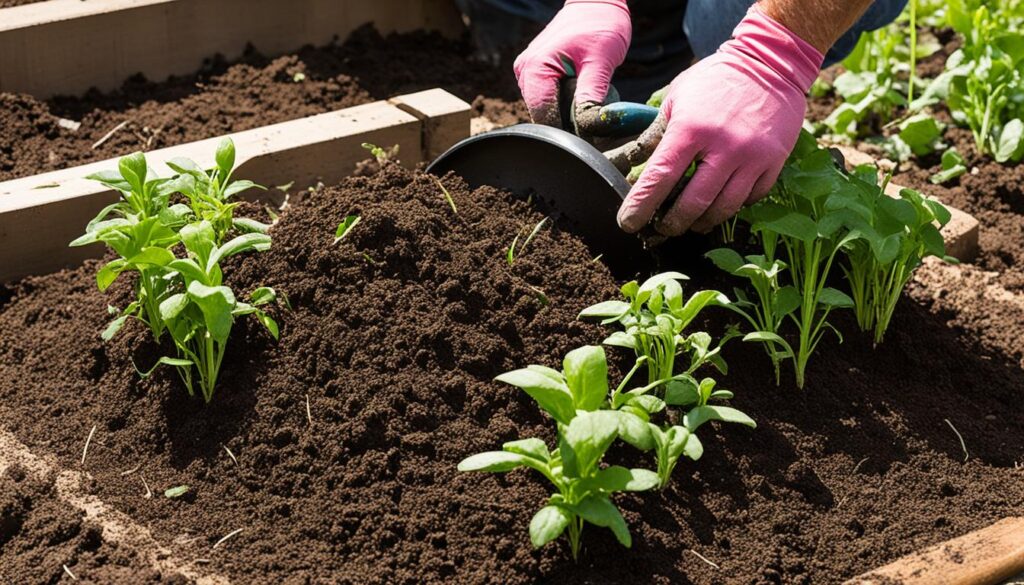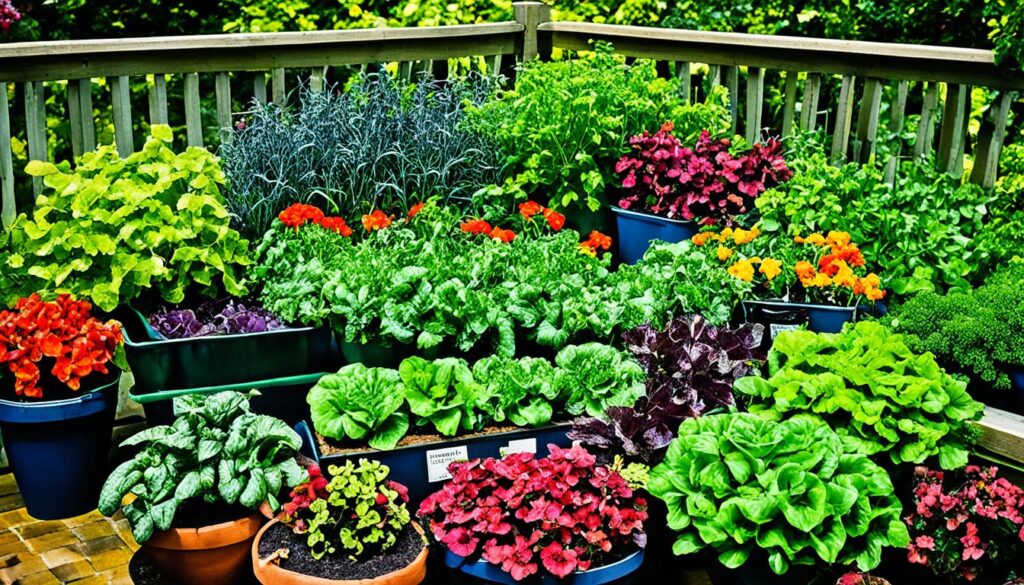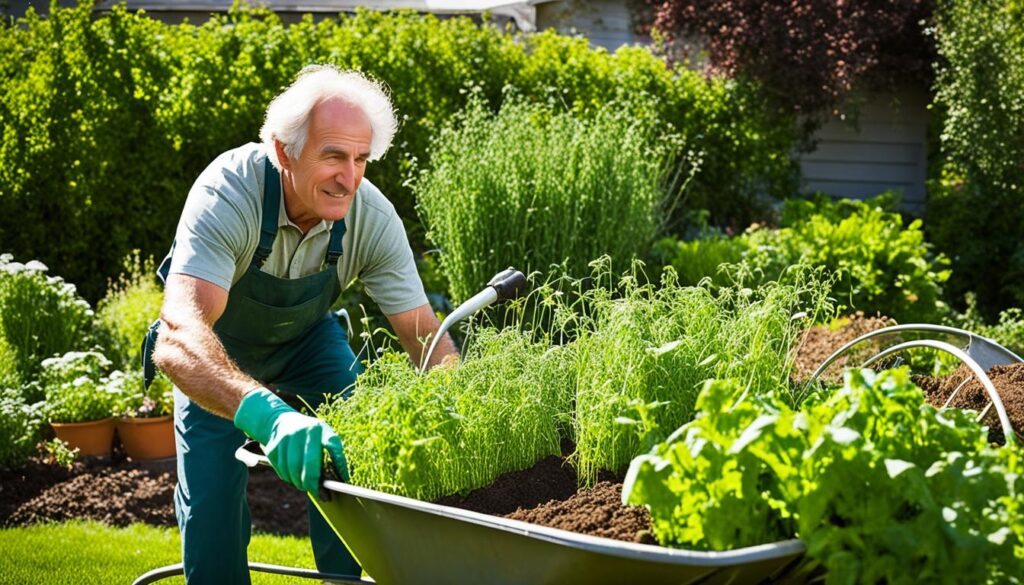Get ready to enjoy growing your own tasty vegetables. This guide will help you get your garden going. If you’re just starting out or wanting to grow more, you’re in the right place. You’ll learn everything you need, from picking the right spot to what to plant.
This step-by-step guide is for first-timers and seasoned gardeners alike. It will help you turn your home into a green paradise. You’ll find out why growing your own food is such a rewarding experience.
First, you’ll learn how to pick the perfect location and prepare the soil. Then, you’ll dive into choosing the best vegetables to plant. Get ready for a journey that will feed both your body and your soul.
Key Takeaways
- Understand the importance of selecting a location with ample sunlight, well-drained soil, and nutrient-rich conditions for optimal plant growth.
- Determine the appropriate garden size, starting small as a beginner and only growing what you know you’ll eat.
- Explore the easiest and most productive vegetables to grow, ensuring your family’s preferences are met.
- Master the art of garden layout, considering plant height, planting times, and staggered harvests for a continuous yield.
- Discover the benefits of homegrown produce, including enhanced flavor, freshness, and control over cultivation methods.
Introduction to Vegetable Gardening
Benefits of Growing Your Own Vegetables
Growing your own vegetables is full of pluses. The veggies you grow are the freshest and tastiest.1 It’s a fun hobby that keeps you outside and moving. This helps stay physically and mentally healthy. You also pick how you grow them, skipping harmful chemicals.
Homegrown veggies are cheaper and more interesting than store-bought. You can find unique types that aren’t available in regular markets.
Reasons to Start a Vegetable Garden
Starting a vegetable garden has many good reasons behind it. You get to eat the best and healthiest produce. What you grow at home is often tastier and higher quality than what you find in stores.1 It’s a wonderful way to stay active, enjoy the outdoors, and relax. Gardening lets you be in charge of how your food is grown. This means no unwanted chemicals.
Having a garden can make your wallet happy by saving on food costs. Plus, you can try growing veggies that are not usually sold in stores.
Choose the Right Location
Finding the perfect spot for your vegetable garden is key. The best location helps your plants grow well and give you lots of veggies. Think about these important things when you pick your garden spot:
Sunny Spot
Many veggies need 6 to 10 hours of sunlight every day. A few, like some leafy greens, can do okay with less light. But most need a lot of sun to do their best.2
Well-Drained Soil
If water sticks around in the soil, plants can get sick and die.3 To solve this, you might make a raised bed. This helps water drain away. Don’t plant in rocky soil; it’s bad for plant roots.
Stable and Not Windy
Strong winds can hurt or even kill baby plants. They can also mess up pollination.4 Pick a spot away from strong winds. Also, avoid places that flood or get a lot of people walking through.
Nutrient-Rich Soil
You need good, rich soil for your vegetables to grow well.3 Add things like compost to your soil. This makes it healthier and helps your plants get the food they need.
Determine Garden Size
Starting small is better for those new to gardening.5 A good size is a 10′ x 10′ plot.5 This size is easy to manage. It doesn’t require as much time and effort.5
Start Small for Beginners
A 10′ x 10′ (100 square feet) garden is great for beginners.5 Only plant what you’ll use to make care easier. Less weeding, watering, and picking.5
Recommended Garden Sizes
For a garden on the ground, try 10′ x 10′ or 12′ x 24′.5 Raised beds work well in 4′ x 4′ or 4′ x 8′ sizes.5 Make sure there’s enough space between plants for you to move around easily.
Start with smaller areas to keep things simple.5 Add more beds or pots as you learn, making your garden bigger over time.5

Select Vegetables to Grow
Starting a vegetable garden means picking easy crops that also bear a lot of fruit. Go for basics like lettuce, green beans, and radishes. Tomatoes, zucchini, and peppers are good choices, too. Don’t forget about beets, carrots, and peas.
Choose Vegetables You Like to Eat
Pick veggies your family loves to eat. Don’t grow what no one will enjoy. It’s all about planting what makes everyone happy.
Consider Availability and Homegrown Benefits
Think about what’s hard to get at the store. Then, plant those fancy or rare items. Things like tomatoes and leafy greens taste better when they come from your own garden.6
Plan Your Garden Layout
When planning your
, think about plant height. Put taller plants on the north side to avoid shading others. This helps everyone get enough sun.7
Arrange Plants Based on Height
Place taller veggies at the back. Or, put them on the garden’s north side. This way, shorter plants get light too. It’s a smart way to make sure all your plants grow well.7
Group Plants by Planting Time
Vegetables don’t all go in at once. It’s easier to manage when you plant the same-time crops together. For example, cool-season plants like lettuce can go in one group, and tomatoes with cucumbers in another.7
Stagger Plantings for Continuous Harvest
If you want veggies all season, plant the same ones some weeks apart. This way, not everything will be ready at the exact same time. You’ll have a steady supply of fresh food.7

How to Start a Vegetable Garden
Starting a vegetable garden is a great way to connect with nature. It’s a journey that can lead you to tasty rewards. This guide will take you through all the necessary steps. It will show you how to pick the right spot and the best vegetables to grow. Everyone can learn from this, whether you’re new or have green thumbs already.
The first step is finding a good spot for your garden. Most veggies need 6 to 8 hours of sun every day.8 They do best with at least six hours. The soil should drain well, have low lead, and be full of nutrients. If the ground is bare, add at least two inches of compost.9
6 If you’re just starting, a garden 10′ x 10′ is a good size. You can plant 3 to 5 of each vegetable in this space.6 Or try a 4′ x 4′ or 4′ x 8′ raised bed. These are great to begin with.9 A 50-75 sq. ft. garden is also a good option for starters.9
Choose veggies that are easy to grow and your family will eat.6 Some top picks for beginners are lettuce, green beans, and tomatoes. Also, zucchini, peppers, and more.8 Beets, lettuce, and cucumbers are good too. Start some crops a few weeks apart to keep a steady supply.6
8 Give your plants 2 to 3 feet of space to grow.8 Start seeds indoors for some varieties six to eight weeks before it gets warm. Some plants, like tomatoes, need warmth and should go outside later.8
9 Your garden should get at least 6 hours of sun every day. More is even better.9 Water deeply around the roots and keep them moist with organic mulch.9 Look out for pests and handle them carefully to protect your plants.9
With these steps, you’re ready to start your vegetable garden. Begin with a small, simple plan. Choose easy vegetables to begin with. Gardening is about learning and enjoying the process. Soon, you’ll be enjoying the fruits of your labor. Happy gardening!
Prepare the Soil
Starting a vegetable garden begins with preparing the soil. This step is vital. You need to make the soil ready for your vegetables to grow well.10
Loosen and Amend Soil
First, use a spading fork or a shovel. Loosen the soil in your garden area well. Get rid of anything you don’t want, like rocks, roots, or weeds. Then, mix in new garden soil or organic matter to make the soil better.10
Add Compost or Manure
Next, add 2-3 inches of compost or manure. This improves the soil with important nutrients. It also helps the soil’s ability to drain water well.10 Your vegetable plants will love growing in this enriched soil.

Planting Your Vegetable Garden
You can plant vegetables by sowing seeds directly or by using seedlings. It’s better to sow seeds directly for beans, carrots, and radishes.6 Transplanting works well for tomatoes and peppers.
Spacing and Depth Guidelines
Make sure to follow the spacing and planting depth tips on the seed packets or plant labels. This will help your vegetables grow right. A 2-3 foot gap between plants is often best.6
Watering After Planting
After you put your garden in, water the seeds or plants well. This helps them get started strong. Keep the soil wet but not soggy until the plants have deep roots.6
How to Start a Vegetable Garden
Container Gardening Basics
If you’re short on space, try a vegetable garden in containers. Pick a 5-gallon bucket or a similar container, making sure it has holes in the bottom. Then, fill it with a good potting mix and plant your veggies.6
Choosing Containers and Soil
Choosing the right container is key. Make sure it’s at least 12 inches deep for the plant roots. Also, use quality potting mix or create your own custom blend for the best growth. This will help your plants get the right drainage they need.11
Watering and Fertilizing
Vegetables in containers need more water than in the ground. The soil in pots dries out fast. Keep an eye on the top inch of soil and water when it’s dry. Also, feed your container plants a balanced vegetable fertilizer to keep them healthy.11

Vegetable Garden Maintenance
Weeding and Pest Control
It’s key to remove weeds often from your vegetable garden. They steal water, nutrients, and sunlight from your plants.1 Be on the lookout for common garden pests. Use methods like picking insects by hand. You can also apply safe soaps or oils to keep them away.1
Watering Techniques
Vegetable plants need even watering, especially when it’s hot and dry.1 Water deeply near the roots and not on the leaves to avoid sickness. Soaker hoses or drip systems are great for saving water.
Fertilizing and Crop Rotation
Feed your vegetable garden with a balanced fertilizer now and then. This will keep the soil healthy for plants.1 Change where you plant your crops every season. This stops pests and disease from getting worse and keeps the soil good for growing.

Conclusion
This detailed guide shares the steps to begin your vegetable garden. Start by picking a sunny spot with six hours of sunlight daily12. Your ideal garden shape should be 10 feet long and 11 rows wide13. For plants, select what your family likes and start small.
Remember to be patient as you improve your gardening skills. Mix in organic matter and water regularly for success12. Your garden will reward you with plenty of tasty and healthy foods.
To protect your plants, use companion planting and organic pest control12. Keep your garden tidy by weeding, pruning, and picking14. Growing your own food also helps the environment by cutting down on food miles and packaging14.
By following this guide, you can create a garden that feeds your family. It will be a fun and rewarding hobby. Enjoy the journey and celebrate your garden’s harvests.
FAQ
What are the benefits of growing your own vegetables?
Homegrown veggies taste the best since you pick them when they’re perfect. Gardening is a fun way to stay active and feel good. It lets you control how your food is grown, so you can skip chemicals.
It’s also cheaper than buying from the store. Plus, you can grow unusual varieties that are hard to find elsewhere.
What are some of the best vegetables for beginner gardeners to grow?
For new gardeners, start with easy plants. This includes lettuce, green beans, and radishes. Tomatoes, zucchinis, and peppers are good too. Beets, carrots, leafy greens, and peas are great for beginners.
What type of soil and sunlight do vegetables need?
Most vegetables need a lot of sunlight, about 6 to 8 hours a day. They grow best in healthy soil. You should add compost or manure to make the soil full of nutrients.
How much space do I need for a vegetable garden?
Start small, like a 10′ x 10′ garden. This is easier for beginners. A plot under 12′ x 24′ for ground gardens does the job.
Raised beds work well too. You can start with a 4′ x 4′ or 4′ x 8′ bed.
How do I plan the layout of my vegetable garden?
Think about how tall your vegetables will grow. Placing tall plants on the garden’s north side keeps them from shading others.
Group plants that need similar conditions together. For example, put plants that like cool weather near each other.
How do I prepare the soil for planting?
Before planting, mix compost or manure into the soil. This adds nutrients and helps with water drainage. Break up the soil and remove any debris like rocks and weeds.
What is the difference between direct sowing and transplanting?
Planting by seed directly in the ground is direct sowing. This works best for beans, carrots, and radishes. Transplanting is moving seedlings to the garden.
It’s better for plants that don’t like their roots disturbed, like tomatoes and peppers. Follow the instructions on your seeds or plant tags for the right depth and spacing.
Can I grow vegetables in containers?
Yes, gardening in containers is great for small spaces. Use a container with drainage holes. Fill it with potting mix and plant your favorite vegetables.
Container plants need more water than those in the ground. Use plant food to keep them healthy.
How do I maintain my vegetable garden?
Keep weeds out of your garden to help your veggies grow. Look out for bugs and use safe ways to get rid of them. Water your plants at root level to avoid wetting leaves, which can cause disease.
Feed your garden with plant food to keep the soil rich. Change where you plant each crop each season. This helps keep bugs away and the soil good for growing.
Source Links
- https://www.bhg.com/gardening/vegetable/vegetables/planning-your-first-vegetable-garden/
- https://fiskars.com/en-us/gardening-and-yard-care/ideas-and-how-tos/planting-and-prep/finding-the-best-spot-in-your-garden-to-grow-food
- https://sebsnjaesnews.rutgers.edu/2020/04/choosing-the-right-location-for-your-vegetable-garden/
- https://melissaknorris.com/podcast/best-location-for-a-vegetable-garden/
- https://www.gardeningknowhow.com/edible/vegetables/vgen/choosing-the-size-of-your-vegetable-garden.htm
- https://www.almanac.com/vegetable-gardening-for-beginners
- https://bonnieplants.com/blogs/garden-fundamentals/lay-vegetable-garden
- https://www.homedepot.com/c/ah/how-to-start-a-vegetable-garden/9ba683603be9fa5395fab90d6de2854
- https://extension.umd.edu/resource/how-start-vegetable-garden
- https://hort.extension.wisc.edu/articles/beginning-vegetable-garden-basics-site-selection-and-soil-preparation/
- https://montanahomesteader.com/how-to-start-a-raised-bed-vegetable-garden-for-beginners/
- https://gardensavvy.com/gardening-blog/gardening-tips/the-ultimate-guide-to-starting-a-vegetable-garden-for-beginners/
- https://jackfrostgardens.com/starting-a-vegetable-garden/
- https://www.theeasygarden.com/threads/beginners-guide-to-creating-a-vegetable-garden-tips-tricks-and-benefits.25080/
